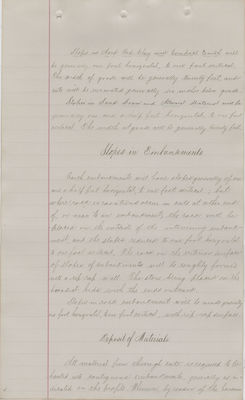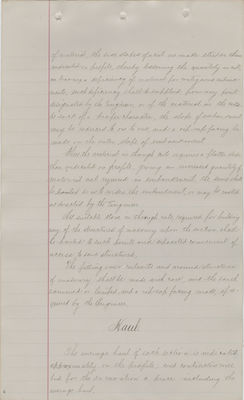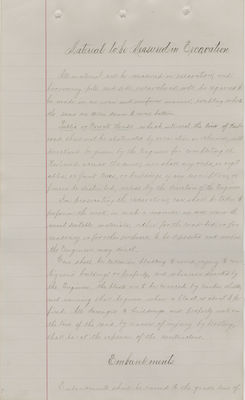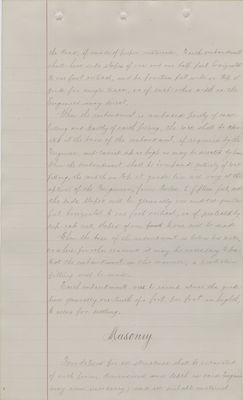Pages
Robinson_09051867__0396
"Slopes"[underlined] in "Hard Red Clay and Compact Earth"[underlined] will be generally one foot horizontal, to one foot vertical. The width of grade will be generally twenty feet, and cuts will be excavated generally six inches below grade.
Slopes in "Sand Loam"[underlined] and "Alluvial Material"[underlined] will be generally one and a half feet horizontal, to one foot vertical. The width at grade will be generally twenty feet.
Slopes in Embankments.[Centered]
Earth embankments will have slopes generally of one and a half feet horizontal, to one foot vertical; but where rock excavations occur in cuts at either end of, or near to an embankment, the rock will be placed on the outside of the intervening embank= ment, and the slopes reduced to one foot horizontal to one foot vertical. The rock on the exterior surface of slopes of embankment[s crossed out] will be roughly formed into a rip-rap wall. The stone being placed on the broadest beds with the ends outward.
Slopes in rock embankment will be made generally one foot horizontal, to one foot vertical, with rip-rap surface.
Deposit of Materials.{centered]
All material from through cuts, is required to be hauled into contiguous embankments, generally as in= dicated on the profile. Whenever, by reason of the hardness
[bottom left margin:] 5
Robinson_09051867__0397
of material, the side slopes of a cut are made steeper than indicated on profile, thereby lessening the quantity in cut, or leaving a deficiency of material for contiguous embank= ments, such deficiency shall be supplied from any point designated by the Engineer, or if the material in the cuts be rock of a proper character, the slope of embankment may be reduced to one to one, and a rip-rap facing be made in the outer slope of embankment.
Where the material in through cuts requires a flatter slope than indicated on profile, giving an increased quantity of material not required in embankment, the same shall be hauled so as to widen the embankment, or may be wasted as directed by the Engineer.
All suitable stone in through cuts, required for building any of the structures of masonry upon the section, shall be hauled to such points as deposited convenient of access to said structures.
The filling over culverts and around structures of masonry, shall be made with care, and the earth rammed or tamped, and a rip-rap facing made, if re= quired by the Engineer.
Haul.[centered]
The average haul of each section is indicated approximately on the profile, and contractors will bid for the excavation a price including the average haul.
[bottom left margin:] 6
Robinson_09051867__0398
If, upon final estimate, the average haul shall appear to have been increased or decreased, a cor-= responding allowance of — per cubic yard per hundred feet may be added to or deducted from the contract prices of material upon the section.
General Details.[centered]
"Earth over Rock Excavation and Indurated or Cemented gravel."[underlined] — In all cases where earth overlies rock, indurated or cemented gravel, an allowance shall be made for an offset or berm not less than three feet from the top slope of the rock excavation, and the slope of the earth excavation over the rock shall be the same as in other earth excavations on the line unless changed by the Engineer. The rock shall be stripped of the earth, if required by the Engineer, prior to commencement of rock excavation.
Slopes in a Cut of Doubtful Material.[centered]
Where the material in a cut is unknown, contractors will be required to open the cut from the ends at grade, with side slopes of one-half to one, and work the same from the face until the different kinds of material are developed by the progress of the work, when the slopes will be changed to corres= pond with the material, by the Engineer.
[bottom left margin:] 6
Robinson_09051867__0399
Material to be Measured in Excavation.[centered]
All material will be measured in excavation, and borrowing pits and side excavations will be required to be made in an even and uniform manner, excepting where the same are taken down to rock bottom.
"Public or Private Roads"[underlined] which intersect the line of Rail= road shall not be obstructed by excavation or otherwise, until directions be given by the Engineer for completing the Railroad across the same; nor shall any crops, or veget= ables, or fruit trees, or buildings of any description, or fences be disturbed, unless by the direction of the Engineer.
In prosecuting the excavations, care shall be taken to perform the work in such a manner as will allow the most suitable materials, either for the road-bed, or for masonry or for other purposes, to be deposited and used as the Engineer may direct.
Care shall be taken in blasting to avoid injury to con= tiguous buildings or property, and whenever directed by the Engineer, the blasts are to be covered by timber shields, and warning shall be given when a blast is about to be fired. All damage to buildings and property not on the line of the road by reason of injury by blasting, shall be at the expense of the contractors.
Embankments.[centered]
Embankments shall be raised to the grade line of
[bottom left margin:] 7
Robinson_09051867__0400
the Road, if made of proper materials. Earth embankments shall have side slopes of one and one-half feet horizontal to one foot vertical, and be fourteen feet wide on top at grade for single track, or of such other width as the Engineer may direct.
When the embankment is composed partly of rock filling and partly of earth filling, the rock hall be depos= ited at the base of the embankment, if required by the Engineer, and carried up as high as may be directed by him. When the embankment shall be composed entirely of rock filling, the width on top at grade line will vary at the option of the Engineer, from twelve to fifteen feet, and the side slopes will be generally one and one-quarter feet horizontal to one foot vertical, or if protected by rip-rap wall, slopes of one "foot"[crossed out] to one will be made.
When the base of the embankment is below low water, or where for other reasons it may be necessary to pro= tect the embankment in this manner, a protection filling will be made.
Earth embankments will be raised about the grade line generally one-tenth of a foot per foot in highth, to allow for settling.
Masonry.[centered]
"Foundations"[underlined] for all structures shall be excavated of such form, dimensions and depth as said Engineer may deem necessary; and all suitable material
[bottom left margin:] 8




